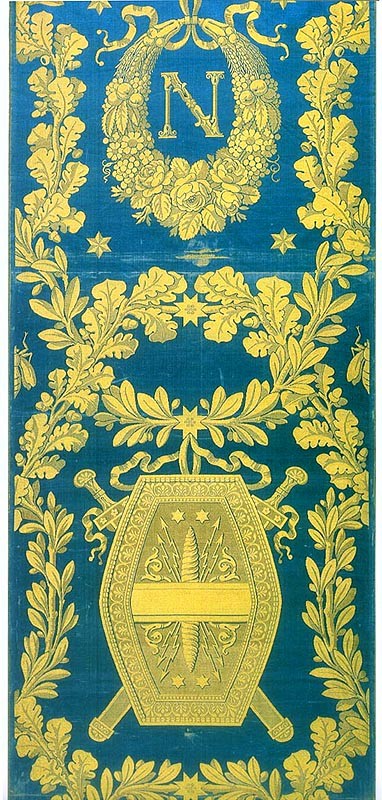The Consulate and the Empire were period of renaissance for the Lyons silk industry, specifically as a result of the refurnishing of the imperial residences. The first commission was for the palace at Saint-Cloud in 1802, the later ones were spread out over the period from 1804 – 1813 for the Tuileries, Fontainebleau, Versailles, Meudon and Compiègne. Initially Camille Pernon was the exclusive supplier to the national furniture store, the Mobilier impérial, before later having to share this privilege with other Lyons makers such as , Grand-frères, Bissardon, Cousin and Bony, Theoleyre and Dutilleu, Lacostat and Trollier, etc.
Designed for the “Premier Salon de l'Empereur” in the palace at Meudon, this three-coloured damask was executed by Grand-frères on a commission of 1808. The Meudon Palace (the Château Neuf de Meudon) was built between 1706 and 1709 by Jules Hardouin-Mansart for the Grand Dauphin, and Napoleon initially detailed it for use by veterans of his Garde consulaire. It was subsequently annexed in 1807 for use as an imperial residence. Following the Emperor's desire to make Meudon a site where the products of French indystry would be showcased, the silk curtains and wall fabrics for the furnishing were all commissioned in Lyon; the designs for the decoration were drawn by the architect Brongniart. That for the damask here was, according to the proposal of 20 May, 1808, in the form of “large compartments formed by interlaced oak and laurel branches enclosing flower and fruit garlands with His Majesty's cypher in the centre of some and antique style shields in the centres of others, with the names of the His Majesty's victories inscribed on them”. Delivered on 24 October, 1809, the material was used for the wall fabrics, curtains, a screen, some sofas, armchairs and chairs placed in the Grand Salon at the end of 1811.
The sovereigns of the Restoration recognised the beauty and quality of the imperial silks and many of them were re-used for other purposes. This blue damaks for example from Meudon was used for the decoration of the duc de Berry's salon at the Tuileries Palace, but the symbols (deemed inappropriate) had to be modified. The Intendant du Garde-Meuble ordered that “suitable pieces of embroidery should be placed over the parts of the fabric where the Ns and other symbols of this sort were to be found […]”.
Karine Huguenaud (tr. P.H.)
April 2005
Blue damask with a yellow border and a shield motif decoration

- Date :
- 1808-1809
- Dimensions :
- H = 125 cm, L = 54 cm
- Place held :
- Lyons, musée des Tissus
- Photo credit :
- © Musée des Tissus

